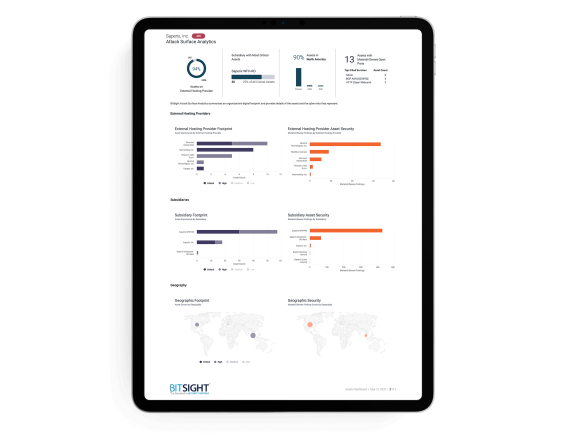Request your free custom report and see how you can start reducing your cyber risk exposure across your digital ecosystem: cloud assets across all geos & subsidiaries; discover shadow IT; security risk findings; and more!
Do You Have What it Takes to Achieve Digital Resilience?

The term “digital resilience” has gained momentum over the past few years as cybersecurity threats have grown, but what does it really mean? And how can a company become digitally resilient?
Merriam-Webster defines “resilience” as “the capability of a strained body to recover its size and shape after deformation caused especially by compressive stress” or, to put it more bluntly: to bounce back. As it relates to cybersecurity, digital resilience is an organization’s ability to return to a state of normalcy after an attack. And though most organizations practice some form of cybersecurity, not all organizations are digitally resilient.
Take the recent SolarWinds supply chain attack, which impacted an expansive amount of organizations. Many of those organizations are still dealing with the impact of the breach, while others were able to get back to “normal” relatively quickly. What’s the difference between the two? Put simply, those who were able to bounce back were more prepared and, thus, showed more digital resilience.

Preparing for digital resilience
Becoming digitally resilient isn’t as simple as putting up a firewall or even adopting a zero-trust approach to protection. Those are core elements of cybersecurity, but cybersecurity and digital resilience are two different things. Cybersecurity includes the strategies and tools companies employ to fend off potential attacks. Building up digital resilience is more about playing the long game to ensure your organization remains as well fortified as possible. It’s about proactively managing risk by always being prepared with the proper resources, tools, and teams to combat it.
There are many different ways organizations can make themselves more resilient, and they’re not necessarily costly or time-consuming. Simply implementing security patches and software updates on a regular basis can go a long way toward laying the foundation for a resilient response if and when an attack should occur. Monitoring the effectiveness of said patches is another practice that can help you become better prepared and more resilient.
Practicing digital resilience
Most CISOs understand that these practices are the security equivalent of brushing their teeth. Where they run into a challenge is when it comes time to implement them.
Fortunately, there are several tools and strategies you and your team can adopt to maintain a proactive and strong approach to risk management, resulting in a more resilient cybersecurity posture:
1. Monitor patching cadence
How often does your company routinely patch its software? How about your third-party vendors? It’s important you know the answers, because maintaining a regular patching cadence is essential for plugging potential security vulnerabilities and protecting your networks and software (again, just ask SolarWinds about the importance of patching).
Patching cadence is one the many risk vectors Bitsight considers when producing our security ratings. These ratings measure an organization’s cybersecurity posture and propensity for risk and can uncover weak areas that need to be addressed. For instance, a security rating report could indicate unpatched systems on your network or even your partners’, exposing possible vulnerabilities you can immediately work to remediate. Find out where your vulnerabilities exist by requesting a free Security Rating Snapshot.
2. Continuously assess third-party risk
Many of today’s hackers target supply chains to do maximum damage with minimal effort. Infiltrating a single supplier can create havoc throughout the chain, adversely affecting every organization using that supplier’s product or service. Thus, it’s important to always protect yourself by monitoring even your most trusted suppliers.
Annual security assessments won’t cut it, not just because they’re too time consuming, but because they only provide a snapshot of a vendor’s security posture at a given point in time. Using security ratings for ongoing third-party risk assessments is a more effective and timely approach. It allows you to identify potential security holes in your supply chain and have honest conversations with vendors about how to fix those holes. You’ll both be more digitally resilient and better prepared to react and mitigate future threats.
3. Get senior management on board
Having senior management on your side is critical to the success of any initiative, including building up your organization’s digital resilience. Fortunately, this shouldn’t be too hard. Cybersecurity has become just as much of a business concern as it has a security issue, with nearly $1 trillion lost to cybercrime in 2020, and board members are taking notice.
To convince the board and senior management of the importance of your mission, you’ll need to share key metrics. You’re also going to have to learn how to present your argument in a way that’s easily digestible yet impactful. Security ratings are great for this because it’s like showing a credit score; they are very easy to understand. But there’s more to getting senior leadership on board with your plan for digital resilience. This practical guide offers useful tips on reporting cybersecurity metrics to the board.
Do you have what it takes?
Creating true digital resilience isn’t something that happens overnight, or even over the course of a year. It’s an ongoing process that takes commitment and ongoing attention. The next cyber threat will undoubtedly be different than the previous one. You need to plan for any contingency, because whatever comes next, you will want to have what it takes to bounce back as quickly as possible.


